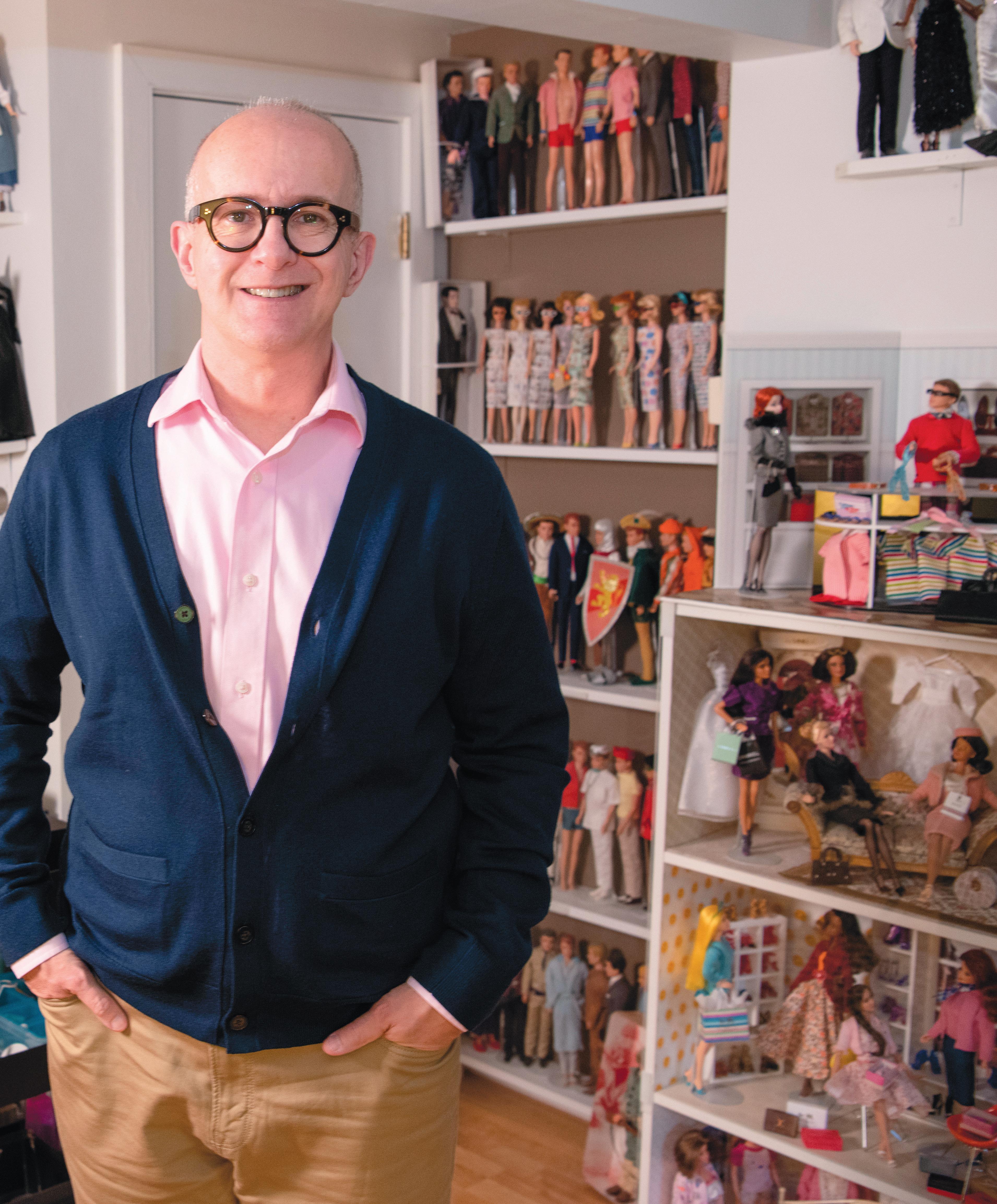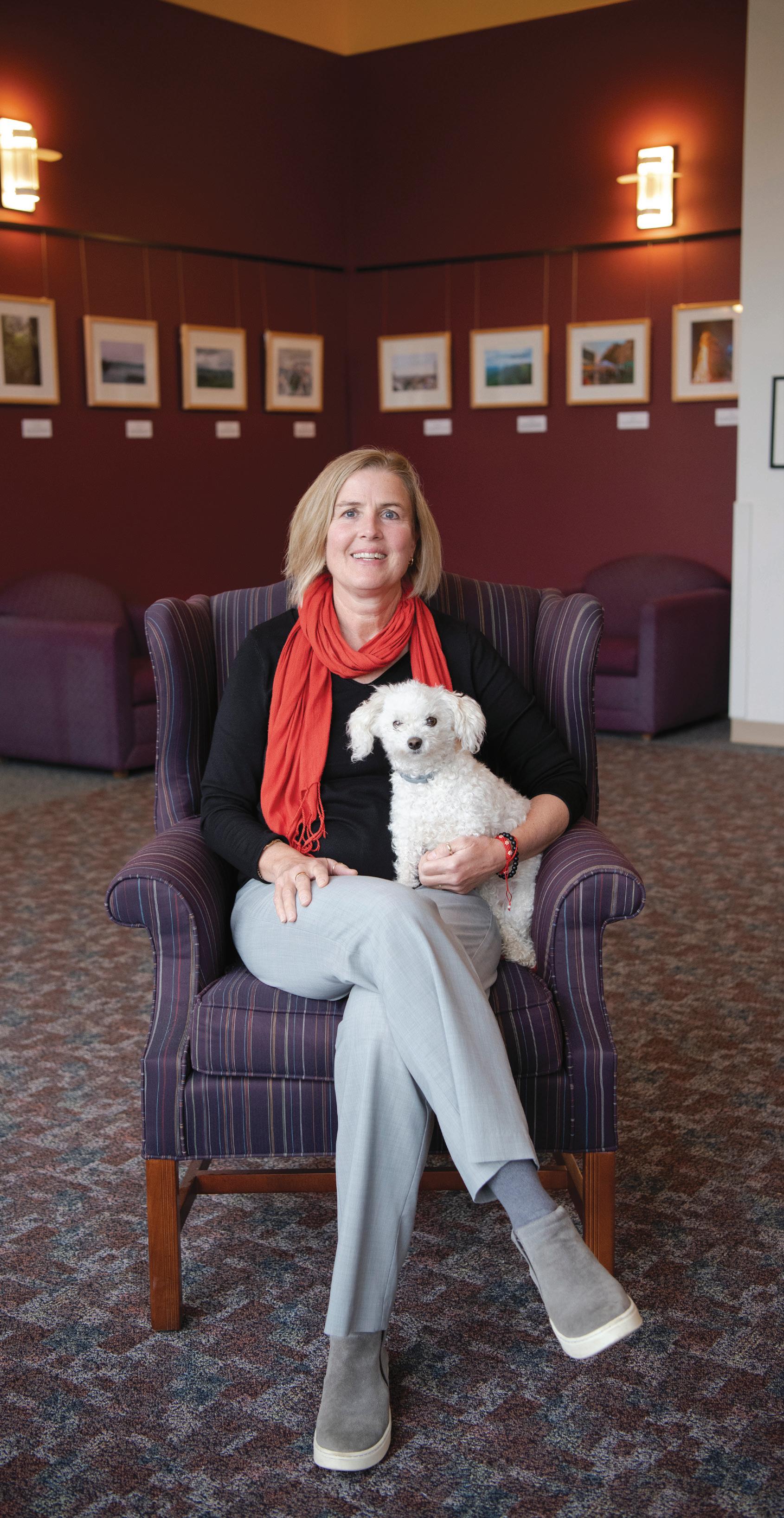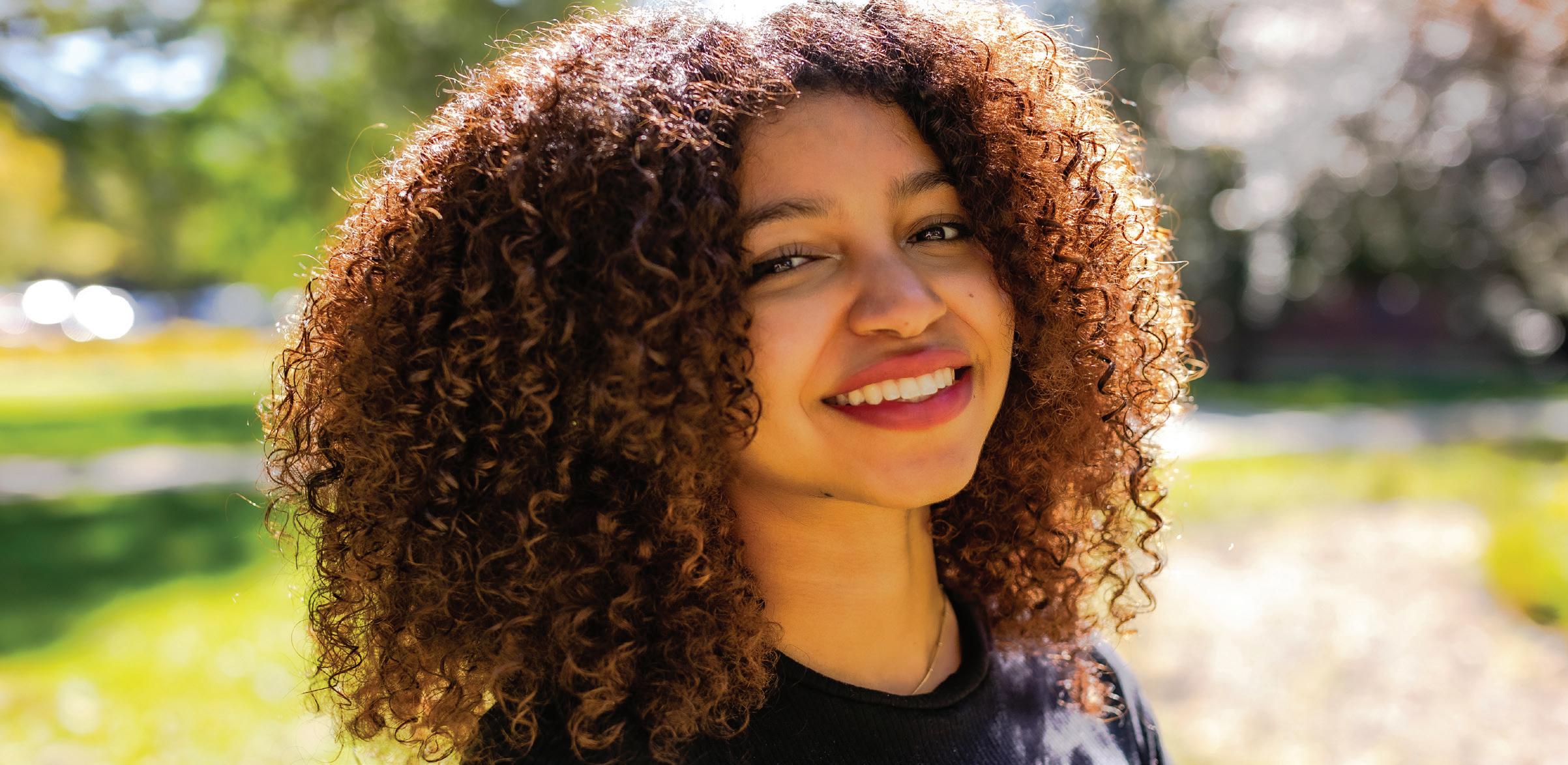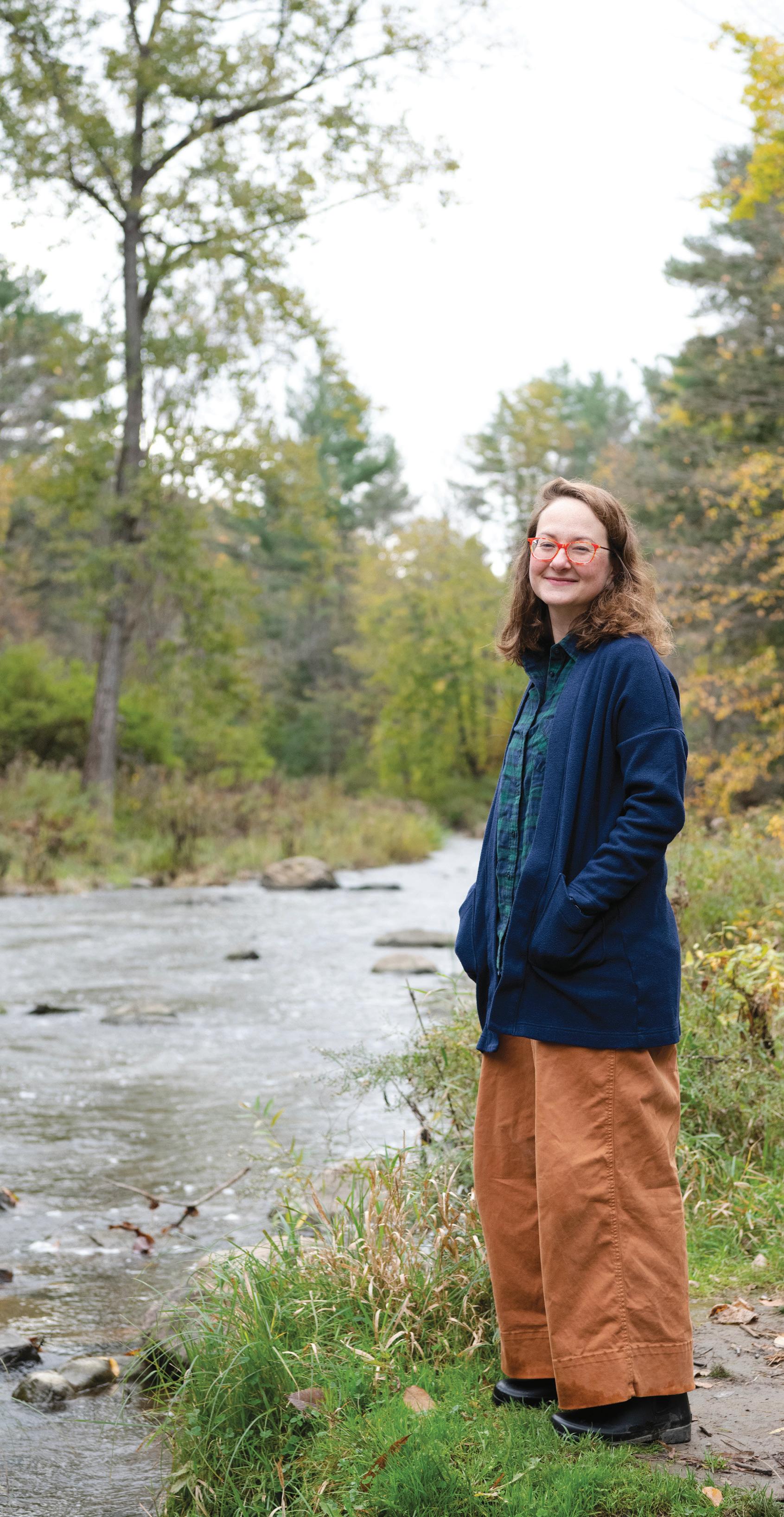
10 minute read
Reinvention
BY SUSAN SALTER REYNOLDS
The Shoelace Factor
In late March 2020, Peter Harrigan, professor of fine arts: theatre, was sewing. Sewing has always been a part of his career, but this time it was different. He began by making 75 masks for family and friends. “You really had to use what you had,” he says. And suddenly, a national shortage of elastic! Harrigan went to the drugstore. He found plenty of shoelaces. They worked fine. He calls this form of reinvention “the shoelace factor.”
On March 15, Harrigan’s father passed away. His mother delivered his father’s clothing, five contractor bags, to Harrigan. “He had bright blue eyes, and he always wore these blue plaid shirts.” Harrigan began sewing. He made a quilt of the blue plaid shirts and gave it to his mother.
“It was lovely therapy, ” he says.
More reinvention: When campus shut down in March, students performed the play they had been working on via Zoom. The following fall, they decided to make a video project, a “theatrical video,” which they are still editing. “It’s humbling,” Harrigan says. “As the director, I’m used to being in control. But I don’t have video editing skills, so I have to convey what I want to other people.” This “letting go” has been another form of reinvention for Harrigan.
The pandemic also inspired a new relationship with his students. He’s moving away from tests, creating new options for projects, and sensing students’ greater willingness to reveal more about their lives in their classwork. “Those gates were closing,” he says of work/ life boundaries pre-COVID.
Finding humor during the pandemic has been challenging, but imperative. Running the Faculty Assembly, Harrigan tried to introduce a bit of levity to the online meetings. “I have a doll collection,” he says, “and I tried to do puppet shows, with the dolls in the meetings. I had a President Sterritt doll—when you pulled the string, she said, “do well, do good.”

Director of Library and Information Services Laura Crain and her dog, Mel. Permission to Be Still

Krystyna Davenport Brown, vice president for institutional advancement, was used to traveling; institutional advancement is hightouch work. “In my field, so much is based on personal relationships, on bringing the St. Mike’s experience to friends and alumni. People crave that reconnection with their alma mater,” she says. How to recreate that personal relationship?
During the pandemic, Davenport Brown has discovered that the telephone works much better than email. “I pick up the phone a lot more, and I find it is possible to have really meaningful conversations.” She has discovered just how important the human voice can be, especially when it comes to nostalgia. “I took a lot of pictures and had many meaningful conversations about Founders Hall before it came down,” she reports. She also rediscovered the art of the handwritten note. “In many ways, these relationships have gotten more personal, more individualized.”
That goes for the traditional work/ home divide as well. “Working from home has really humanized people. We get snapshots of their lives. And when my 6-year-old wanders into the room while I’m in a meeting and says ‘Mom, I’m hungry,’ well, I’m going to get her a snack!” Davenport Brown says she has a renewed understanding of what really matters. “In my line of work, you are always trying to prove you can go 24/7. I’ve given myself permission to be still.”
Renewed Social Justice in the Library
In the spring of 2020, Laura Crain, director of library and information services, adopted a 4-year-old lapdog, named Mel, a “bringer of joy.” The library closed that spring,

Marlon Hyde ’21 (left) at a Vermont Lake Monster’s baseball game for a VPR story.
and reopened in the fall, but for Crain, home life in the pandemic has been framed by her relationship with Mel.
“Student well-being is always the priority,” she says of her professional obligations. “In the library, we found ourselves connecting more with students. We offered books and cookie deliveries to quarantined students.” The library, Crain reminds her listener, has always been a social space. Technology has changed library spaces, but that change was on its way well before the pandemic. Libraries have been on the forefront of what Crain calls change management, including the rapidly evolving ways people find information and the ways information is produced and accessed.
But the library ethos hasn’t changed. “Libraries are welcoming spaces,” she says. In regular meetings with the Vermont Consortium of Academic Libraries, library directors discussed how to keep that ethos alive, despite mask-wearing and social distancing.
The pandemic has also renewed Crain’s interest in fighting misinformation. She sees helping students question bias in the media and adopt a balanced “information diet” as one of the fundamental goals of academic libraries, and she has been giving more time to advocacy on this and various social justice issues. “We have to ensure that our collections are diverse,” she says. At St. Mike’s, library staff have reviewed areas of the collection to make sure representation in fiction and nonfiction is balanced.
The Earth Will Outlast Us
For Marlon Hyde ’21, news fellow at Vermont Public Radio, the stress of the pandemic forced a new chapter with an interesting reinvention: increased self-care. Exercising, eating, product choices all came under fresh scrutiny. Hyde, who majored in Media Studies, Journalism, and Digital Arts, found that the flexibility enabled by remote work inspired an increase in his creativity. Finding ways to be calm, to de-stress, and to relax proved critical in helping ideas “to flow easier.” Sometimes that involves music, sometimes it just means wearing the right hoodie. And sometimes it means connecting with friends.
Like Crain, Hyde believes the pandemic sped up the advancement of media technology in ways that were altogether too slow in coming in the before times. YouTube channels, podcasts, and social media content “bloomed and blossomed because of the number of people that now had time to view what they were producing.” During the pandemic, Hyde has become more interested in health and climate change, subjects that prepandemic, he felt drawn to but didn’t have time to pursue. Traveling in Morocco before March 2020, Hyde found himself in conversations about how climate change was affecting the way viruses travel. Once the pandemic hit, the urgency around these subjects for Hyde, and many others, increased. “We are running out of time to address many of the human-made issues that this planet unfortunately must suffer through. What I’ve learned is, the earth will outlast us,” he says.
Finding Her Place
For Misha D’Andrea ’15, the pandemic caused a tectonic shift in priorities and goals. “Early in the pandemic, we were forced to pay attention to various cultural events. After the murder of George Floyd I had to stop. I could no longer claim to be too busy to pay attention. Those of us with privilege had to pay attention.” D’Andrea made the leap from her job in higher education in employer relations at Tufts University to a position as an inclusion coach and facilitator in the diversity, equality, and inclusion department of Cloudera, a tech company.
While at Tufts, D’Andrea participated in an “Unpacking Whiteness Dialogue,” in which participants meet for 1.5 hours a week for six weeks to have a dialogue on systemic inequities in the U.S. She became a facilitator for the series and then went to the University of Southern Florida for a certificate in diversity, equity, and inclusion (DEI) in the workplace. When the opportunity arose at Cloudera, she jumped. “Tech moves a lot faster than higher ed,” she explains. “In tech, if you have an idea, most of the time you can run with it. There’s much more autonomy.”
D’Andrea has experienced profound changes in her life since the pandemic. She experienced a lot of guilt for what she calls her “complacency.” The pause necessitated by the pandemic gave her the breathing room she needed. “I had to figure out how I could be part of the solution. My passion is now my full-time job and the pandemic was a catalyst for making that happen.” Urgency Makes the Heart Grow Fonder?
Ashley DeLeon ’23 was overwhelmed in the fall of 2020. She had just started editing for the Defender, and by spring term she had become its executive editor. With only half of the staff available to work on stories, DeLeon was keenly aware of how much the student body depended on the Defender for information. “People were getting laid off at the College, there were tensions between students and Public Safety, COVID guidelines

Ashley DeLeon ’23
were changing. People were looking to us for information.” When DeLeon started writing for the Defender in her first year, there was much less urgency, less hunger for information.
“COVID made me love journalism even more,” she says. “My sense of obligation to my audience only grew.” During the pandemic, the stories DeLeon worked on involved more investigative journalism. Stories in the national news about students not following restrictions and the outbreak at Saint Michael’s demanded attention and response. DeLeon, forced to cover all sides of many stories, felt a renewed sense of community.
“I think the mood on campus today is, well, grateful,” she says, a note of relief in her voice. “Being sent home was a bummer. The confusion around COVID regulations was a bummer. People have started paying attention in ways they weren’t in the beginning of the pandemic. They seem much happier.”
The Visible Profession
One of the bittersweet consequences of the pandemic, for Candas Pinar, assistant professor of sociology, is that there’s been a remarkable growth in interest in the field of public health among Saint Michael’s College students. “I’ve found a lot of meaning in sharing my research interests with them. One of the most significant challenges that public health professionals face is that public health
is an ‘invisible profession.’ You may not really know what public health is or what public health professionals do until there’s a disaster. The COVID-19 pandemic has, unfortunately, brought to light the significance of public health, disease prevention, and the social determinants of health.”
Pinar’s teaching has changed postpandemic. “I have always erred on the side of teaching with empathy and care, and I think the pandemic has only affirmed my commitment to this approach. Last year, I began carving out time in my classes to build connection and community among students, and I’ve held onto this in my teaching,” she says. “I’ve also come to embrace flexibility more than ever before so that I can better serve the needs of students. Last year, that meant diving deep into the world of digital pedagogy to learn about how to create a meaningful learning experience for students online. This year, perhaps in response to more than a year of teaching through digital platforms, I’ve gone in the opposite direction, bringing classes outdoors as much as possible so that we can simply sit with a text and with each other.”
Pinar’s work habits and research methods have largely stayed the same, but her commitment to collaboration has deepened. “I’m a big believer in team science. Especially as someone who does research that lies at the intersection of multiple disciplines, I have always enjoyed collaborating with scholars from different corners of the academic universe. The social isolation brought about by the pandemic has only reaffirmed my enthusiasm for co-authorship and collaborative research. Like so many other parents of young children, I have had to change the way I work in response to waves of school closures and quarantines. It has meant that the lines between work and family have been blurred in ways that I previously never would have imagined.”

Candas Pinar, assistant professor of sociology, enjoys a stroll along a Vermont stream close to her home.










